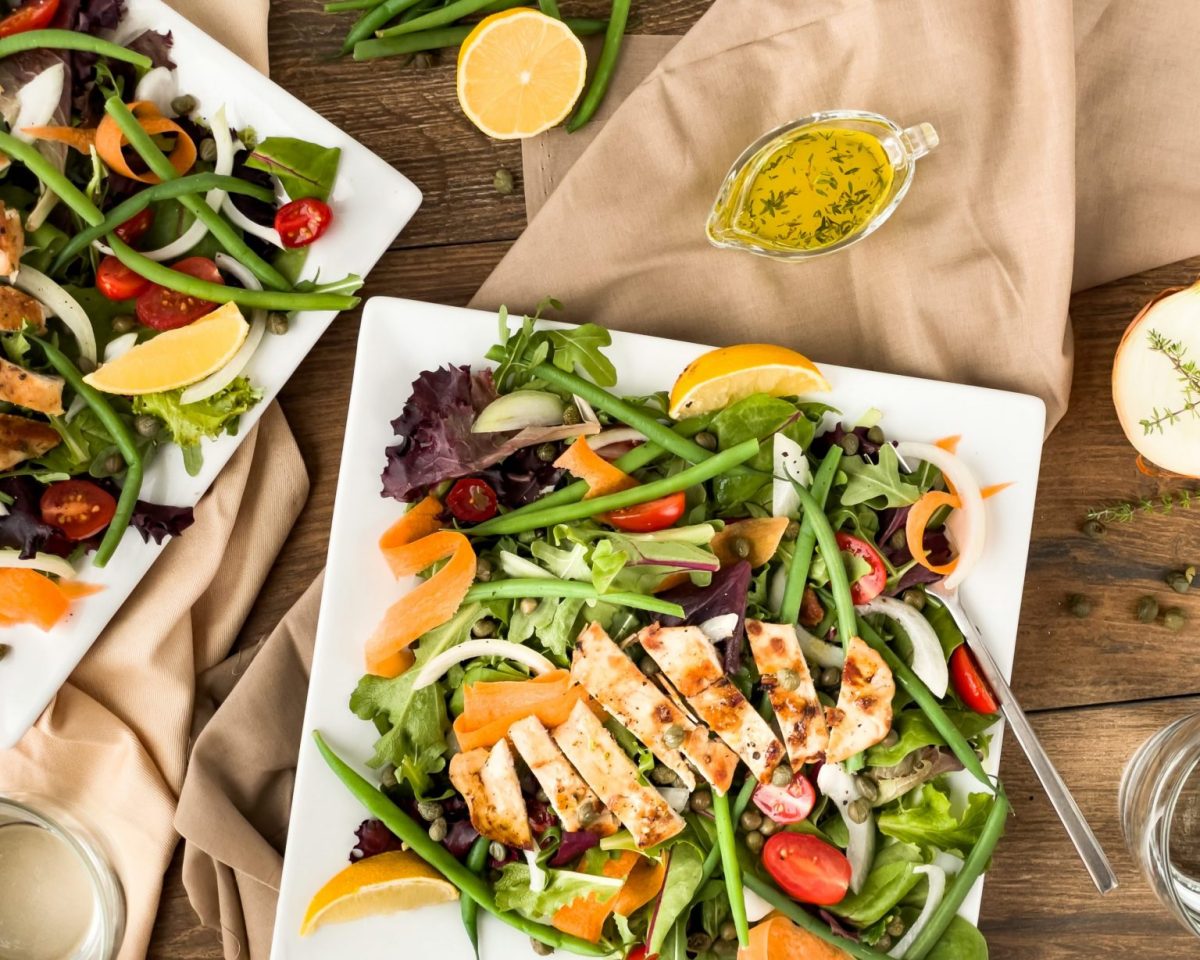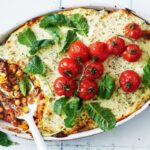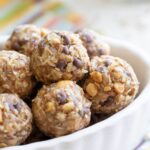Embark on a culinary adventure with this comprehensive guide to creating delicious and satisfying dinners, even with dietary restrictions. Imagine vibrant plates overflowing with flavor, carefully crafted to be both hearty and allergy-friendly, completely free from gluten and dairy. We’ll explore a diverse range of recipes, offering detailed instructions and helpful substitutions to accommodate various needs, ensuring everyone can enjoy a delicious and healthy meal.
From robust main courses packed with protein to complementary side dishes bursting with freshness, this guide provides a complete toolkit for meal planning and preparation. Learn valuable techniques for adapting recipes, managing common allergens, and optimizing your grocery shopping for efficiency and minimal waste. Discover the joy of creating wholesome, allergy-conscious meals that are as visually appealing as they are nutritious.
Main Course Options

Creating hearty, allergy-friendly dinners can be surprisingly simple and delicious. These recipes focus on naturally gluten-free and dairy-free ingredients, offering satisfying meals packed with flavor and nutrition. Each dish is designed to be adaptable to various dietary needs and preferences, ensuring everyone can enjoy a wholesome and delicious meal.
Five Hearty Gluten-Free and Dairy-Free Main Course Recipes
These recipes provide a variety of flavors and textures, showcasing the versatility of allergy-friendly cooking. Each recipe includes detailed instructions and nutritional information (per serving) based on average ingredient quantities. Note that nutritional values may vary slightly depending on specific ingredients used.
Recipe 1: Lemon Herb Roasted Chicken and Vegetables
Ingredients: 1 whole chicken (about 3 lbs), 1 lemon (sliced), 2 tbsp olive oil, 1 tbsp dried herbs (rosemary, thyme, oregano), 1 lb carrots (chopped), 1 lb potatoes (chopped), 1 onion (quartered).
Instructions: Preheat oven to 400°F (200°C). Place chicken in a roasting pan. Rub with olive oil and herbs. Stuff lemon slices inside the cavity. Arrange vegetables around the chicken. Roast for 1 hour and 15 minutes, or until chicken is cooked through and vegetables are tender.
Nutritional Information (approx.): Calories: 450, Protein: 40g, Fat: 25g, Carbohydrates: 20g
Recipe 2: Spicy Shrimp and Coconut Curry with Cauliflower Rice
Ingredients: 1 lb shrimp (peeled and deveined), 1 tbsp coconut oil, 1 onion (chopped), 2 cloves garlic (minced), 1 red bell pepper (chopped), 1 can (13.5 oz) full-fat coconut milk, 1 tbsp red curry paste, 1/2 cup cauliflower rice, salt and pepper to taste.
Instructions: Heat coconut oil in a large skillet. Sauté onion and garlic until softened. Add bell pepper and curry paste, cook for 2 minutes. Stir in coconut milk and cauliflower rice. Bring to a simmer and cook for 5 minutes. Add shrimp and cook until pink and opaque (about 3-5 minutes). Season with salt and pepper.
Nutritional Information (approx.): Calories: 380, Protein: 35g, Fat: 20g, Carbohydrates: 15g
Recipe 3: Sheet Pan Salmon with Asparagus and Sweet Potatoes
Ingredients: 4 salmon fillets (6 oz each), 1 bunch asparagus (trimmed), 2 large sweet potatoes (cubed), 2 tbsp olive oil, salt, pepper, paprika.
Instructions: Preheat oven to 400°F (200°C). Toss sweet potatoes and asparagus with olive oil, salt, pepper, and paprika. Spread on a baking sheet. Place salmon fillets on the same sheet. Bake for 15-20 minutes, or until salmon is cooked through and vegetables are tender.
Nutritional Information (approx.): Calories: 420, Protein: 30g, Fat: 22g, Carbohydrates: 30g
Recipe 4: Lentil Shepherd’s Pie with Sweet Potato Topping
Ingredients: 1 tbsp olive oil, 1 onion (chopped), 2 carrots (chopped), 2 celery stalks (chopped), 1 cup brown or green lentils, 4 cups vegetable broth, 1 tsp dried thyme, 2 large sweet potatoes (cooked and mashed), salt and pepper to taste.
Instructions: Heat olive oil in a large pot. Sauté onion, carrots, and celery until softened. Add lentils, vegetable broth, and thyme. Bring to a boil, then reduce heat and simmer for 25-30 minutes, or until lentils are tender. Season with salt and pepper. Top with mashed sweet potatoes and bake at 375°F (190°C) for 15-20 minutes.
Nutritional Information (approx.): Calories: 350, Protein: 25g, Fat: 10g, Carbohydrates: 50g
Recipe 5: Black Bean Burgers with Avocado Crema
Ingredients: 1 (15-ounce) can black beans (rinsed and drained), 1/2 cup cooked quinoa, 1/4 cup chopped onion, 1/4 cup chopped cilantro, 1 tbsp chili powder, 1 tsp cumin, salt and pepper to taste, 1 ripe avocado, 2 tbsp lime juice, 1/4 cup water.
Instructions: Mash black beans with a fork. Combine with quinoa, onion, cilantro, chili powder, cumin, salt, and pepper. Form into patties. Cook in a skillet over medium heat for 5-7 minutes per side, or until heated through. For the avocado crema, blend avocado, lime juice, and water until smooth. Serve burgers on gluten-free buns (optional) with avocado crema.
Nutritional Information (approx.): Calories: 300, Protein: 18g, Fat: 15g, Carbohydrates: 35g
Recipe Comparison Table
This table summarizes key features of each recipe, allowing for easy comparison based on protein source, cooking time, and flavor profile.
| Recipe | Protein Source | Cooking Time (approx.) | Key Flavor Profile |
|---|---|---|---|
| Lemon Herb Roasted Chicken and Vegetables | Chicken | 75 minutes | Savory, Herbaceous |
| Spicy Shrimp and Coconut Curry with Cauliflower Rice | Shrimp | 15-20 minutes | Spicy, Coconutty |
| Sheet Pan Salmon with Asparagus and Sweet Potatoes | Salmon | 15-20 minutes | Savory, slightly sweet |
| Lentil Shepherd’s Pie with Sweet Potato Topping | Lentils | 45-50 minutes | Hearty, comforting |
| Black Bean Burgers with Avocado Crema | Black Beans | 15-20 minutes | Savory, slightly spicy, creamy |
Recipe Versatility and Substitutions
Each recipe offers significant versatility. For instance, the roasted chicken recipe can easily incorporate different vegetables based on seasonal availability or personal preference. The curry can be adjusted in spiciness by altering the amount of curry paste. In the lentil shepherd’s pie, other root vegetables like parsnips or turnips could be substituted for carrots. The black bean burgers can be customized with different spices or additions like finely chopped vegetables. These are just a few examples of how these recipes can be adapted to suit individual needs and tastes.
Meal Planning & Preparation Strategies
Crafting a weekly menu of hearty, allergy-friendly dinners requires careful planning and preparation. This involves not only selecting recipes but also optimizing your shopping trips and cooking process to ensure efficiency and minimize food waste. By implementing effective strategies, you can enjoy delicious, healthy meals without the stress of last-minute meal decisions or ingredient shortages.
Weekly Meal Planning
A well-structured weekly meal plan is the cornerstone of successful allergy-friendly cooking. Consider the recipes you’ve chosen, factoring in factors like cooking time, ingredient overlap, and your available time each day. For instance, a Monday might feature a quicker recipe like a simple stir-fry, while a weekend could accommodate a more elaborate slow-cooked dish. Visualize a vibrant weekly calendar, each day showcasing a colorful, allergy-friendly masterpiece ready to nourish your family. Remember to account for leftovers, perhaps repurposing them into a new meal later in the week to reduce food waste. For example, leftover roasted chicken could become a hearty chicken salad for lunch or a flavorful addition to a soup.
Efficient Grocery Shopping and Food Storage
Before heading to the store, create a detailed shopping list based on your meal plan. This prevents impulse buys and ensures you have all the necessary ingredients. Categorize your list by grocery store sections to streamline your shopping experience. Imagine yourself smoothly navigating the aisles, gathering only the items you need. Upon returning home, prioritize proper food storage to maintain freshness and prevent spoilage. Store perishable items like fresh produce and herbs in the refrigerator, while pantry staples should be kept in airtight containers to maintain their quality. Regularly check your refrigerator and pantry to identify items nearing expiration and plan meals accordingly. This mindful approach minimizes waste and maximizes the value of your grocery purchases.
Batch Cooking and Meal Prepping
Batch cooking and meal prepping are invaluable time-saving techniques for allergy-friendly cooking. Select recipes that lend themselves well to larger batches, such as soups, stews, or casseroles. Dedicate a specific day for cooking, preparing larger quantities of components like roasted vegetables or cooked grains. These components can then be incorporated into various meals throughout the week. Picture your freezer, neatly organized with individual portions of pre-cooked ingredients and complete meals, ready to be thawed and enjoyed on busy weeknights. This significantly reduces cooking time during the week, leaving you with more time to enjoy your allergy-friendly creations. For example, preparing a large batch of gluten-free brown rice can be used as a base for several different dishes throughout the week.
It’s All About the Recipe
This section delves into the detailed preparation of one allergy-friendly recipe, providing a step-by-step guide with visual descriptions and explanations for each stage. Understanding the rationale behind each step empowers you to confidently recreate the dish and adapt it to your preferences. Mastering these techniques will build your confidence in preparing delicious and healthy meals that cater to dietary restrictions.
Sweet Potato and Black Bean Chili
This vibrant, hearty chili is naturally gluten-free and dairy-free, packed with flavor and nutrients. The recipe below showcases a simple yet effective method for creating a deeply satisfying meal. Each step is crucial in developing the complex layers of taste and texture.
- Sautéing the Aromatics: Begin by finely chopping one large onion and two cloves of garlic. Imagine the onion, a pearly white globe, transformed into delicate, translucent slivers under the heat. The garlic, initially pale and firm, releases its pungent aroma as it softens into a golden-brown paste. Heat two tablespoons of olive oil in a large, heavy-bottomed pot over medium heat. Add the onion and cook until softened, about 5 minutes, stirring occasionally. Then add the garlic and cook for another minute until fragrant. This initial step builds the foundation of flavor for the entire chili.
Remember to use a heavy-bottomed pot to ensure even heat distribution and prevent burning.
- Building the Flavor Base: Stir in one tablespoon of chili powder, one teaspoon of cumin, half a teaspoon of smoked paprika, and a quarter teaspoon of cayenne pepper (optional, for added heat). The chili powder, a rich reddish-brown, lends its earthy warmth; the cumin adds a subtle, nutty depth; the paprika contributes a smoky sweetness; and the cayenne, if used, introduces a fiery kick. Cook for one minute, stirring constantly, to toast the spices and release their full aroma. This step intensifies the flavors and creates a complex spice profile.
Toasting the spices before adding other ingredients unlocks their full potential and prevents a bitter taste.
- Adding the Vegetables: Add one large chopped bell pepper (any color) and one cup of chopped carrots. Picture the vibrant bell pepper, perhaps a sunny yellow or deep red, adding a sweet crunch. The carrots, initially orange and firm, will soften and contribute a gentle sweetness. Cook for 5-7 minutes, stirring occasionally, until the vegetables are tender-crisp. This adds texture and further develops the flavor profile.
Don’t overcook the vegetables; you want them to retain some bite.
- Incorporating the Beans and Sweet Potatoes: Stir in two (15-ounce) cans of black beans (rinsed and drained), one (15-ounce) can of diced tomatoes (undrained), and two large sweet potatoes, peeled and cubed. The black beans, dark and glossy, add a hearty texture and protein. The diced tomatoes contribute acidity and moisture. The sweet potatoes, a rich orange-yellow, will soften and add a natural sweetness. Add 4 cups of vegetable broth. Bring the mixture to a simmer, then reduce heat to low, cover, and cook for 20-25 minutes, or until the sweet potatoes are tender. This is where the chili develops its rich, cohesive flavor.
Ensure the sweet potatoes are fully cooked before serving; undercooked sweet potatoes can be hard and unpleasant.
- Finishing Touches: Season with salt and pepper to taste. A squeeze of lime juice at the end adds a bright, acidic note that balances the richness of the chili. Garnish with fresh cilantro, if desired, for a vibrant pop of color and fresh flavor. The final step elevates the chili from a good meal to a truly satisfying experience.
Taste and adjust seasoning as needed. Everyone’s palate is different!
Mastering the art of allergy-friendly cooking doesn’t mean sacrificing flavor or satisfaction. This guide empowers you to confidently create hearty and delicious dinners tailored to your specific needs. By exploring diverse recipes, learning practical substitution techniques, and embracing efficient meal-planning strategies, you can transform your kitchen into a haven of healthy and flavorful culinary creations. Enjoy the journey of discovering new tastes and textures while nourishing your body and delighting your senses.
Clarifying Questions
Can I freeze these meals for later?
Yes, many of these recipes freeze well. Allow them to cool completely before storing in airtight containers.
What if I have an allergy not covered in the substitutions?
Consult an allergist or registered dietitian for personalized advice on substitutions and safe food choices.
Are these recipes suitable for children?
Yes, many are adaptable for children, but always check for potential choking hazards and adjust spice levels accordingly.
How long do the prepared side dishes last in the refrigerator?
Most side dishes will last 3-4 days in the refrigerator when stored properly in airtight containers.


